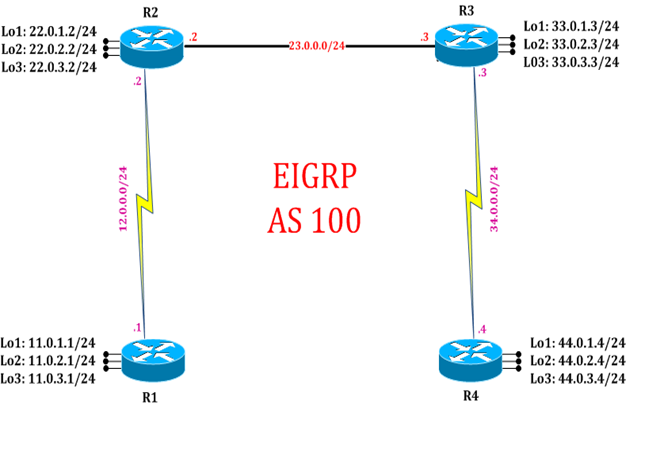EIGRP Named - Passive Interface
Passive Interface
EIGRP (Enhanced Interior Gateway Routing Protocol) Named Mode introduces the concept of a named passive interface, allowing network administrators to control routing information exchange on specific interfaces. In this context, a passive interface is one that does not actively participate in EIGRP routing updates. By assigning a name to a passive interface in EIGRP Named Mode, administrators can conveniently apply the passive behavior to multiple interfaces sharing the same characteristics. This enhances network management by providing a more structured and scalable approach to configuring passive interfaces. Essentially, EIGRP Named Passive Interface simplifies the process of restricting routing updates on certain interfaces, contributing to improved network stability and security by preventing unnecessary information exchange on designated links.
Lab:
Disclaimer
This Configuration Guide is designed to assist members to enhance their skills in particular technology area. While every effort has been made to ensure that all material is as complete and accurate as possible, the enclosed material is presented on an Dzas isdz basis. Neither the authors nor Forum assume any liability or responsibility to any person or entity with respect to loss or damages incurred from the information contained in this guide. This configuration guide was developed by Forum. Any similarities between material presented in this configuration guide and any other material is completely coincidental.
Cisco IOS Software, Linux Software (I86BI_LINUX-ADVENTERPRISEK9-M), Version 15.2(4)M1, DEVELOPMENT TEST SOFTWARE

Task 1: Configure IPv4 EIGRP process with Passive interface using named configuration
Step 1: In the configuration mode of router configure EIGRP process with a name using network 0.0.0.0 by following command
R2:
router eigrp cisco
address-family ipv4 autonomous-system 100
network 0.0.0.0
exit
Step 2: Enter address-family default interface configuration mode and suppress EIGRP updates using “passive-interface” command
R2:
router eigrp cisco
address-family ipv4 autonomous-system 100
af-interface default
passive-interface
After suppressing EIGRP updates by using passive-interface command using named configuration, all interface is suppressed and not been seen.
R2# show ip eigrp interfaces
EIGRP-IPv4 VR(cisco) Address-Family Interfaces for AS(100)
Xmit Queue PeerQ Mean Pacing Time Multicast Pending
Interface Peers Un/Reliable Un/Reliable SRTT Un/Reliable Flow Timer Routes
Step 3: Exit address-family interface default interface configuration mode and enter address-family interface serial 2/0 mode and Un-suppress EIGRP updates using “ no passive-interface” command
R2:
exit-af-interface
af-interface serial 2/0
no passive-interface
exit
After un-suppressing EIGRP updates on serial 2/0 using no passive-interface command, only Serial 2/0 interface is un-suppress and is seen in eigrp interface table.
R2 #show ip eigrp interfaces
EIGRP-IPv4 VR(cisco) Address-Family Interfaces for AS(100)
Xmit Queue PeerQ Mean Pacing Time Multicast Pending
Interface Peers Un/Reliable Un/Reliable SRTT Un/Reliable Flow Timer Routes
Se2/0 1 0/0 0/0 11 0/16 56 0
R2:
exit-af-interface
af-interface default
no passive-interface
exit
R2 #show ip eigrp interfaces
EIGRP-IPv4 VR(cisco) Address-Family Interfaces for AS(100)
Xmit Queue PeerQ Mean Pacing Time Multicast Pending
Interface Peers Un/Reliable Un/Reliable SRTT Un/Reliable Flow Timer Routes
Se2/0 1 0/0 0/0 11 0/16 56 0
Et0/0 1 0/0 0/0 1 0/2 50 0
Lo1 0 0/0 0/0 0 0/0 0 0
Lo2 0 0/0 0/0 0 0/0 0 0
Lo3 0 0/0 0/0 0 0/0 0 0
Task 2: Verification:
Step 1: Verify EIGRP neighborship by following command:
R2#show ip eigrp neighbors
EIGRP-IPv4 VR(cisco) Address-Family Neighbors for AS(100)
H Address Interface Hold Uptime SRTT RTO Q Seq
(sec) (ms) Cnt Num
1 23.0.0.3 Et0/0 12 00:13:54 1 100 0 15
0 12.0.0.1 Se2/0 11 00:19:33 11 100 0 13